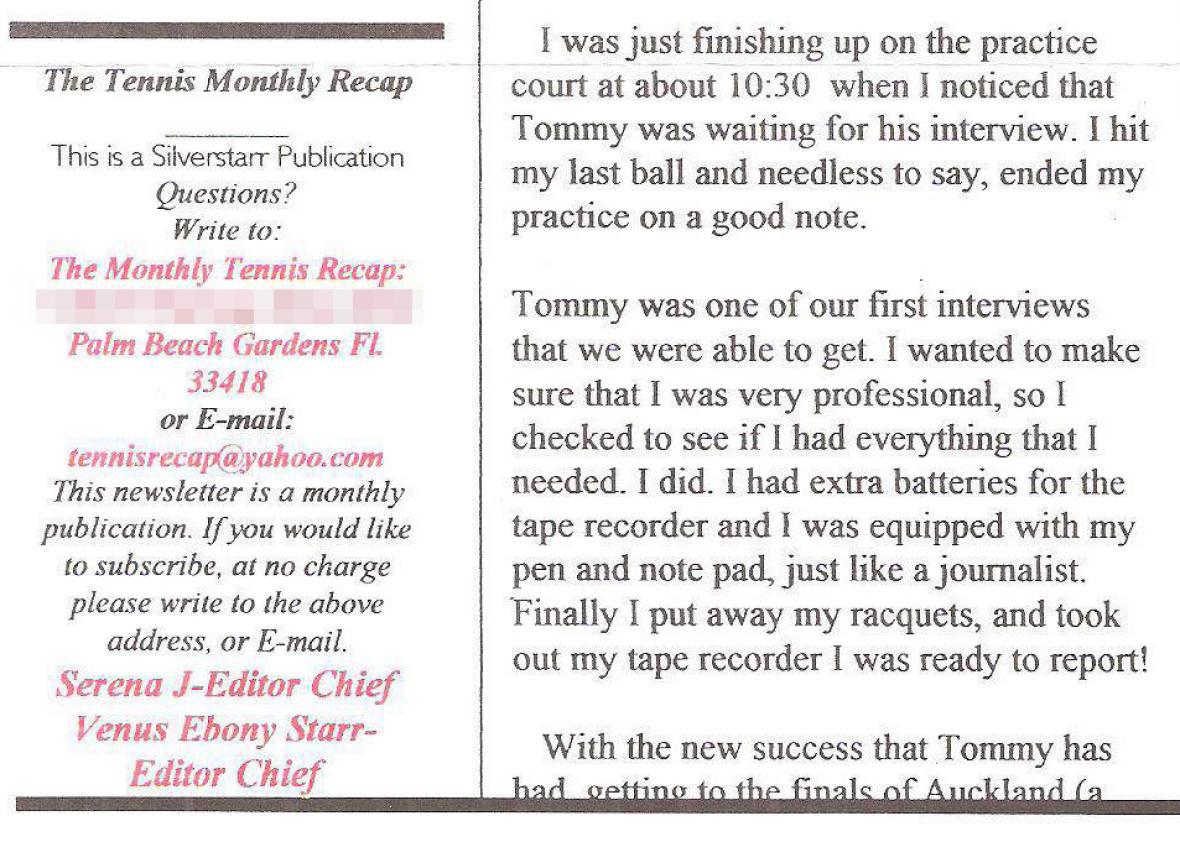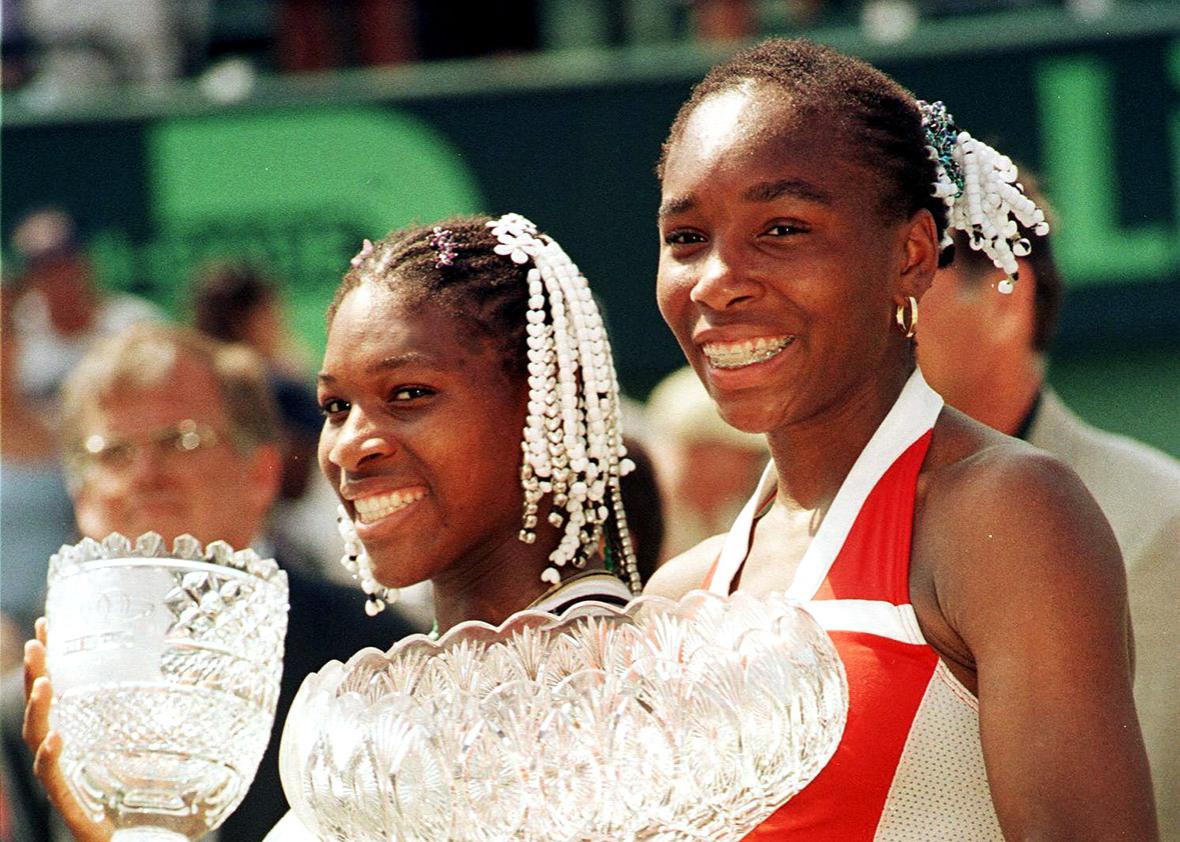Heading into her historic calendar Grand Slam bid at the U.S. Open, Serena Williams has received more media attention than at any other point in her storied career. But before she stared out from the newsstands this week (gracing the covers of Sports Illustrated, New York magazine, and the New York Times Magazine), and before she won any of her 21 Grand Slam titles, Williams tried her own brief stint on the other side of the podium, tape recorder and notepad in hand.
As teenagers still learning the ropes of the tour, Serena and her older sister Venus took the unusual step of documenting the sport themselves. In an era long before blogging or even tweeting made authorship a relatively uncomplicated task for professional athletes, the Williams sisters took the initiative to create their own newsletter. Tennis Monthly Recap, which debuted in 1998, had news about Pete Sampras and Steffi Graf, feature articles, stories about their dogs, interviews with fellow pros, tour gossip, and even a tagline: “The Official newsletter read and written by the pros!”
A copy of one 1999 edition of the newsletter offers a glimpse into the minds, innocence, and humanity of Serena and Venus that is a truly astounding artifact, a primary source for insight into two of the most overanalyzed figures in sports history. At a time when they were already two of the most talked about and polarizing athletes in the world, the sisters produced a newsletter that was at once playful yet professional, whimsical yet comprehensive, fluffy yet substantive.
The precocious sisters, seen by many at the time as outsiders in the sport, took the initiative to start the newsletter in late 1998, when Venus was 18 and Serena was 17. They distributed their first copies of TMR the next year at the Australian Open, and attracted more attention months later when the newsletter was widely disseminated at a tournament in Key Biscayne. The idea bemused journalists at the time, who saw it as yet another inexplicable venture from one of the most enigmatic families in sports history.
Asked about the endeavor in a news conference at that tournament, Serena said the original idea was from Venus.
“It was her idea and we just grew it,” Serena said. “Now it’s getting pretty big. Too big.”
Despite the increasingly daunting scale of the project, Williams said she enjoyed being a journalist.
“Maybe one day you will see me in here asking questions for the Tennis Monthly Recap,” she suggested.
That wouldn’t happen, sadly. Though frequently mentioned in articles about the sisters in 1999, TMR and the memory of it understandably stagnated as the careers of both Venus and Serena soared. After a brief presence online at tennismonthlyrecap.com, the newsletter faded from view and memory almost entirely.
This summer tennis lover and effectual archivist Stephanie Neppl found a perfectly preserved copy of the newsletter hidden deep in her stacks of tennis magazines and clippings. The newsletter’s masthead lists “Serena J” and “Venus Ebony Starr” under the title of “Editor Chief.” The issue found by Neppl was from March 1999, and is listed as their fourth. There is also an address in their hometown of Palm Beach Gardens listed, as well as the email address tennisrecap@yahoo.com.
The majority of the first two pages are devoted to a feature interview titled “Tommy Haas: Der German King.” Serena, writing in first-person, describes not only the interview, but her own nervousness (“because lets face it—I am a tennis player, not a reporter!”) and her preparation for conducting it in an office at the Nick Bollettieri Academy, where Haas and Williams both trained.
“Tommy was one of our first interviews that we were able to get. I wanted to make sure that I was very professional, so I checked to see if I had everything that I needed,” the 17-year-old writes. “I did. I had extra batteries for the tape recorder and I was equipped with my pen and note pad, just like a journalist. Finally I put away my racquets, and took out my tape recorder I was ready to report!”

Via Stephanie Neppl
Serena describes Haas’ initial incredulity at being interviewed by a fellow player, but she seems to eventually win him over with her earnest preparedness. She pays special attention to note small details about the interaction like his “strong German accent,” how he sometimes appeared “jaded,” and his various facial expressions and smiles which she describes at various times as “wry,” “wide,” “sinister,” and eventually “covering his entire face.”
It reads like a well-written high school newspaper article or yearbook entry, with a strange combination of self-consciousness, self-absorption, and confidence. It’s exactly what you’d expect from someone her age, but not necessarily from someone who had devoted almost every day since she was 9 years old preparing to be the best tennis player on the planet.
Serena sounds particularly confident, understandably, in her tennis analysis, describing Haas’ growing mental toughness and throwing in a bit of constructive criticism: “Tommy, although doing much better, can still use a little more patience and variety in his game.” Whether this is her own analysis, or she’s merely channeling Bollettieri—who she notes interrupted the interview at one point—it’s a direct and seemingly astute observation. It’s unsurprising that she’d be able to make that sort of assessment of a fellow player, considering she would ultimately come to understand the game as much or better than anyone in history, but her willingness to so publicly critique an older male player at 17 shows a gumption foretelling her future greatness.
When I showed the article to Haas this summer (at 37, he is one of the few players remaining on tour older than 35-year-old Venus and 34-year-old Serena), it triggered memories of an unusual interview filled with laughter, but also remarkable dedication.
“It was a 1-on-1 with Serena,” he recalled. “You know how she is—both of them—they’re very smart people with very good humor, and usually they do the work, they do the research. Everything they touch, if they’re into it, they go full speed at it. I remember them being professional; they had their stuff lined up. But it was very humorful and fun and easygoing. It was a different thing.”
Haas said the sisters marching to their own drum meshed with the reputation for independence that the family had maintained since first arriving at the academy, raising eyebrows for eschewing the typical junior circuit. He remembers the newsletter being received similarly: with initial trepidation, but ultimately garnering respect.
After the feature on Haas, the third page of the newsletter is devoted to a roundup of happenings in the tennis world that previous February, called “What’s the 411?” The lead story, naturally, was about Venus and Serena becoming the first sisters to win WTA tournaments in the same week, when Serena won her first pro title in Paris and Venus defended her Oklahoma City crown. (If Serena wins the U.S. Open to complete the first calendar Grand Slam since 1988, it will be her 70th singles title since she turned pro.)
In a surprising pivot, the next two items were obits, reporting on the deaths of Dutch player Menno Oostings and American tournament director Bill Talbot. Though much of the text was lifted directly from an Associated Press article on Talbot’s death, someone on the TMR staff made the unfortunate misstep of conflating him with Tony Trabert, who was mentioned in the AP obituary for Talbot, likely leaving TMR as the lone publication to eulogize “Bill Trabert.”
Never a publication to pull punches, TMR then informs readers that Yevgeny Kafelnikov “appeared nervous” when he squandered an opportunity to become the first Russian man to claim the No. 1 ranking. Then, in another quick pivot, there is a reminder that their address and email availabilities are listed on the first and third pages of the issue and a note saying suggestions for topics and “comments on our tennis coverage in general” are welcome. That is followed by an update on the activities of the organization’s prides and disappointments, with the duo’s ambition for the project clearly apparent in a description of their ongoing efforts to secure a Pete Sampras interview.

Via Stephanie Neppl
The 411 wraps on a confounding and playful note, with what appears to be an inside joke. “Blava is a virus! He may also be contagious!” the newsletter alerts in all bold. “He has caused widespread hysteria and is probably the main cause of most nervous breakdowns!”
The fourth and final page of the newsletter is perhaps the most endearing of all: a spread detailing the available information on several players sharing the same first name, titled “The Nicolas’ of Tennis.” In an exhaustive survey of the rankings in the 1998 handbook for the men’s tour, TMR found five men with forms of the name in the top 250, and four from 251-500.
TMR then explained its thinking, and in another sweet bit of sincerity, a disclosure for anyone seeking current, definitive Nicolas information.
Of course, most of us do not pay much attention to the number of people in a sport with the same first name and TMR is not saying that you necessarily should, but we thought that all the readers out there would like to know the stories behind the men with this popular name.
Unfortunately, the staff of TMR (a grand total of two!) irresponsibly lost TMR’s sole copy of the 1999 ATP Tour guidebook. All of the information may not be up to date, but we hope that you don’t notice unless of course, you are an avid Nicolas supporter!”

Via Stephanie Neppl
In describing Frenchman Nicolas Escude’s appreciation for his coach, the writer injects one last personal note into the story: “He credits his success to former tour pro Tarik Benhabiles. ‘He knows how to approach me and there is a complicity between us outside the courts and on the courts and he brought a lot to me.’ Isn’t this the coach everyone wishes for?”
Venus, rarely one to betray much emotion, expressed some shock when I showed her the found issue of TMR last month at a tournament in Cincinnati.
“Dear lord,” Venus exclaimed, as if seeing a ghost. She admired her past initiative—“Hey, if you have an idea, move on it!”—and also considered its ultimate failing: “I think we hated writing, so that’s why we didn’t continue. I never liked writing.”
Serena, who had taken the lead with the Haas feature, was more impressed in looking back at her past work.
“No way—oh my God, I totally need that,” she bubbled. “That is crazy! It’s so professional.”
While she struggled to think of what software they would have used to publish it, realizing it would have predated her exposure to Microsoft Word, Serena was particularly proud of the Nicolas idea—“we were smart back in the day”—and recalled TMR as a grassroots effort that may have foreshadowed the plight of print media in years ahead.
“We would stay in the tournament hotel, and we would just leave them on the tournament desk,” Serena recalled. “We’d print like 50 to 100. We were a small company; unfortunately we went out of business. We were first to go out of business. Always the first!”
Her days as a media mogul are behind her for now, but Serena has before never had a bigger audience, eager to see what history she will write. Maybe, after some well-deserved rest and relaxation in the off-season, Serena can update us about the six new guys in the top 250 named Nicolas.
